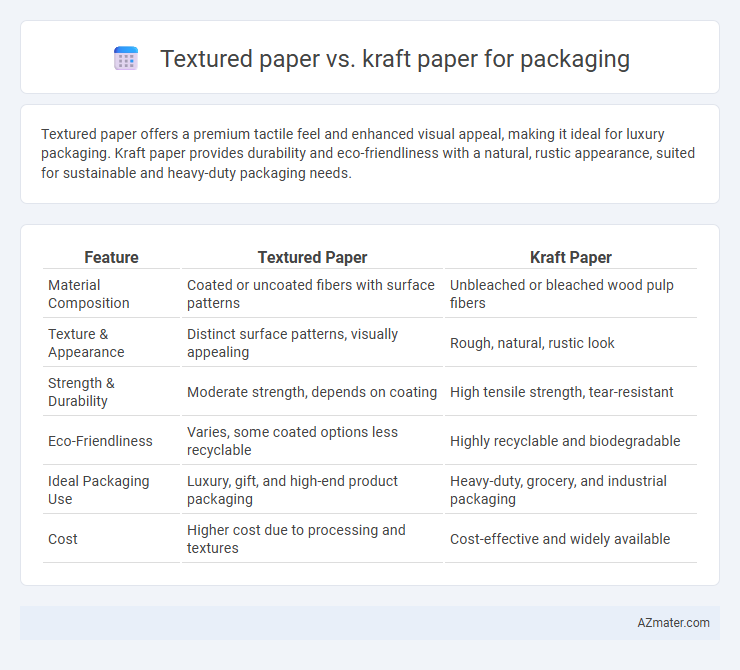Textured paper offers a premium tactile feel and enhanced visual appeal, making it ideal for luxury packaging. Kraft paper provides durability and eco-friendliness with a natural, rustic appearance, suited for sustainable and heavy-duty packaging needs.
Table of Comparison
| Feature | Textured Paper | Kraft Paper |
|---|---|---|
| Material Composition | Coated or uncoated fibers with surface patterns | Unbleached or bleached wood pulp fibers |
| Texture & Appearance | Distinct surface patterns, visually appealing | Rough, natural, rustic look |
| Strength & Durability | Moderate strength, depends on coating | High tensile strength, tear-resistant |
| Eco-Friendliness | Varies, some coated options less recyclable | Highly recyclable and biodegradable |
| Ideal Packaging Use | Luxury, gift, and high-end product packaging | Heavy-duty, grocery, and industrial packaging |
| Cost | Higher cost due to processing and textures | Cost-effective and widely available |
Introduction to Textured Paper and Kraft Paper
Textured paper features a distinct tactile surface created through embossing or specialized finishes, enhancing aesthetic appeal and providing a premium feel for packaging. Kraft paper, made from natural wood pulp using the kraft process, is valued for its strength, durability, and eco-friendly properties, making it ideal for sustainable packaging solutions. Both materials serve distinct functions in packaging: textured paper emphasizes design and branding, while kraft paper prioritizes robustness and environmental responsibility.
Core Differences Between Textured and Kraft Paper
Textured paper features a distinct surface finish that enhances visual appeal and tactile experience, making it ideal for luxury packaging and branding. Kraft paper is characterized by its strength, durability, and natural brown color, commonly used for eco-friendly and heavy-duty packaging applications. The core difference lies in textured paper's aesthetic focus versus Kraft paper's functional strength and sustainability benefits.
Material Composition and Production Process
Textured paper features a surface with embossed or raised patterns created through mechanical pressing or chemical treatments, enhancing tactile appeal and visual depth, while Kraft paper is produced from wood pulp via the kraft process, resulting in a strong, coarse material known for its durability and eco-friendly qualities. The production of textured paper involves additional finishing techniques like calendaring or embossing to achieve the desired texture, contrasting with Kraft paper's straightforward, high-yield pulping and minimal chemical alteration that preserves its natural brown color and fibrous integrity. Material composition of textured paper often includes cellulose fibers combined with additives for smoothness and printability, whereas Kraft paper maintains a higher lignin content which contributes to its rigidity and resistance to tearing, making each suited to different packaging needs and aesthetic preferences.
Visual Appeal and Branding Potential
Textured paper offers a premium tactile experience and sophisticated visual depth, enhancing brand perception through its unique surface patterns that convey luxury and attention to detail. Kraft paper, known for its natural, rustic look and earthy brown tones, appeals to eco-conscious brands by emphasizing sustainability and organic authenticity in packaging design. Both materials influence consumer perception, with textured paper elevating high-end branding while Kraft paper strengthens eco-friendly brand identity.
Durability and Protective Qualities
Textured paper offers enhanced durability due to its embossed surface, providing better resistance to wear and tear compared to smooth kraft paper. Kraft paper, renowned for its high tensile strength and natural fiber composition, excels in protecting heavier or bulkier items by absorbing shocks and preventing punctures. Both materials afford eco-friendly packaging solutions, but textured paper provides superior aesthetic appeal while kraft paper remains a cost-effective option for robust protection.
Printability and Customization Options
Textured paper offers enhanced printability with its unique surface allowing vibrant ink absorption and detailed graphic reproduction, ideal for high-end packaging designs. Kraft paper provides robust customization options through natural, earthy tones and a sturdy texture that supports various printing techniques like flexography and letterpress. Both materials cater to different branding needs, with textured paper excelling in aesthetic appeal and kraft paper emphasizing durability and eco-friendly customization.
Environmental Impact and Sustainability
Textured paper, often made from recycled fibers and biodegradable materials, generally offers a more visually appealing option with moderate environmental benefits, as it is usually recyclable and compostable depending on coatings. Kraft paper, produced from virgin wood pulp through a chemical process, is highly durable, biodegradable, and widely recyclable, making it a preferred choice for eco-friendly packaging with lower environmental footprint. Both papers contribute to sustainability, but kraft paper's natural composition and stronger recyclability position it as a more environmentally responsible material in packaging applications.
Cost Comparison and Budget Considerations
Textured paper generally costs more than Kraft paper due to its specialized surface finish and higher production expenses, making it less suitable for tight budgets. Kraft paper offers a cost-effective packaging solution with its durability and affordability, ideal for businesses prioritizing budget efficiency without sacrificing strength. When comparing costs, Kraft paper provides the best value for bulk packaging needs, while textured paper suits premium branding with a higher budget.
Ideal Use Cases in Packaging
Textured paper excels in luxury packaging and boutique product presentation, offering a tactile, high-end feel that enhances brand perception. Kraft paper is ideal for eco-friendly, durable packaging needs, commonly used in shipping, grocery bags, and rustic or natural product branding due to its strength and recyclable properties. Choosing between them depends on whether the focus is on premium aesthetics or sustainability and robustness in packaging.
Choosing the Right Paper for Your Packaging Needs
Textured paper offers a sophisticated, tactile finish that enhances brand perception and is ideal for luxury packaging, while kraft paper provides durability and eco-friendly properties suited for heavy-duty, sustainable packaging. Selecting between textured and kraft paper depends on your packaging requirements, including product protection, visual appeal, and environmental impact. Consider factors such as print quality, cost, and recyclability to choose the optimal paper that aligns with your brand identity and packaging functionality.

Infographic: Textured paper vs Kraft paper for Packaging
 azmater.com
azmater.com